Rice Goddesses of Indonesia, Cambodia and Thailand
The women of Angkor Wat, frequently called devata and apsaras, are related to many divine, semi-divine and mortal Asian females. While researching flying goddesses (like the apsaras manifesting from the Sea of Milk at Angkor Wat), I began following threads about the Indonesian rice goddess, Dewi Sri. Rice Goddesses of Indonesia, Cambodia and Thailand
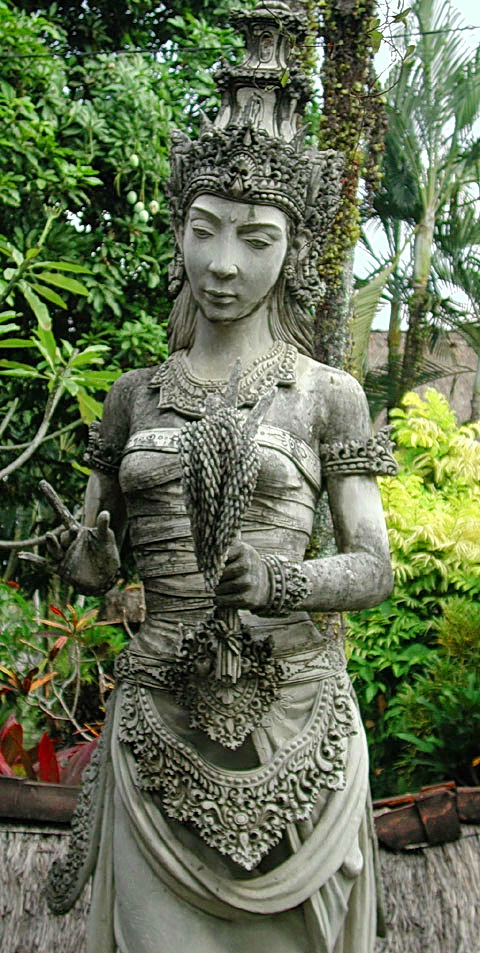
Sadly, ancient images of Dewi Sri are scarce to the point that I could find none…so we have to settle for this attractive, but modern, reproduction from Wikipedia. Still, it’s interesting to note that her accouterments and demeanor are immediately reminiscent of the devata of Angkor Wat. Rice Goddesses of Indonesia, Cambodia and Thailand
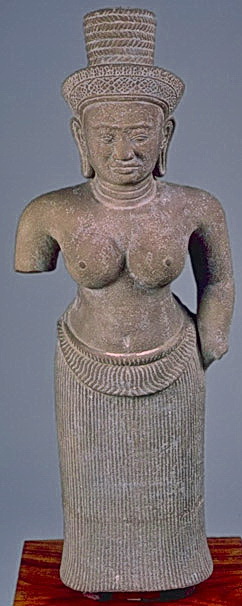
Dewi Sri is associated with rice, water, the moon…and is believed to have dominion over the underworld…domain of the serpent or Naga race…the very same race that are progenitors of the Khmers.
Cambodia’s closest equivalent goddess seems to be Po Ino Nogar, whose name means “great one” in Khmer, and is sometimes associated with the Hindu goddess Uma. Po Ino Nogar is revered because she brings fertility and agricultural bounty to the earth and its people. Like the heavenly apsaras seen at Angkor Wat, she is also associated with the sky, clouds and water, and is sometimes symbolized as a gentle rain.
It is interesting to note that Po Ino Nogar is polyandrous, with 97 husbands. She also has 38 daughters, one of whom, Po Yan Dari, is supposedly a goddess of disease and death who lives in caves and grottos. However, in a Cham version of this tale, the daughter is named Pajau Tan, and she is seen as a divine healer. According to that legend, Pajau Tan was so successful raising the dead that she disrupted normal life and was finally sent to live on the moon. Another daughter of Po Ino Nogar is “the Mouse Queen” (Po Bya Tikuh), perhaps related because of the threat mice pose to the rice crop.
I’ve been unable to locate an image of Po Ino Nogar (please comment to provide info below) but Thailand’s rice goddess is quite popular and quite visible. Known as Mae Posop (แม่โพสพ) she is still honored as the goddess of fertility and abundance as this article from August 9, 2008 explains: Queen Sirikit of Thailand presided over a ceremony.
Since ancient times, Cambodian and Thai royalty have commemorated the beginning of the rice growing season with an annual Royal Plowing Day Ceremony in the month of May.
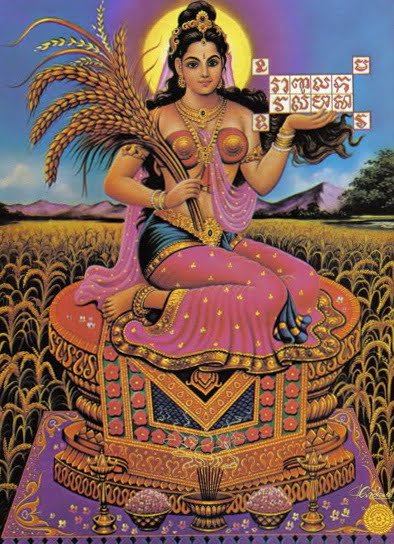
This all seems relevant to our investigation of sacred Khmer women for a few reasons:
1. The iconography of the devata of Angkor Wat is also associated with fertility, growth and abundance.
2. Associations with naga (divine serpents), water, the underworld and the moon also potentially link these sacred females.
3. Java, the home of Dewi Sri, has proven ties to the Khmer civilization in ancient times (10th to 13th century).
Article by Kent Davis
To conclude, let’s read a bit more about rice and tradition with our guest writer, and food aficionado, Vipp Rongsit from Thailand…
Thai Rice and the Ceremony of the Rice Goddess: Mae Posop
By Vipp Rongsit
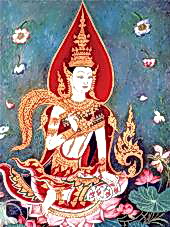
Rice is the mainstay of the Siamese diet and economy. It is always served with salads, meats, poultry, fish, and sea food. Two-thirds of the Thai people earn a living from rice farming. They produce enough not only to feed themselves, but also to be one of the world’s largest rice exporters. Rice farming is the greatest single contributor to national income, providing almost half of Thailand’s export earnings, and major support of government revenues. When one hires a servant in Siam, it is customary to supply rice in addition to salary.
Besides its economic importance, rice has a deep psychological and cultural meaning for the Thai, according to Phya Anuman Rajadhon, distinguished Thai historian and scholar of the customs and traditions of his country. When a Siamese wishes to say he is hungry, he says, “Hiu khao” or “I’m hungry for rice.” When he is eating, he says, “Tan khao” or “I’m eating rice.” Even when he refers to food in general he uses the word khao, meaning rice.
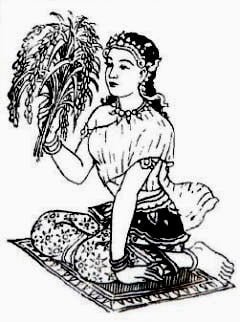
There are many rituals and ceremonies that accompany rice farming, and, while some are losing their vitality with the passing of the older generation, others are practiced today. These observances are founded on the belief that there is a Rice Goddess or Rice Mother, Mae Posop (แม่โพสพ), who, if properly worshiped and propitiated, will reward the farmer with prosperity and good health. For those who deny her, only poverty and sickness will be their end.
It is said that she first came to reside in the land of the rice fields from Mount Meru, the home of the Hindu-Buddhist gods. Her journey over the Seven Seas and the Seven Mountain Ranges was long and tortuous. And on her heels came the many fish which today are still so plentiful in Siamese waters.
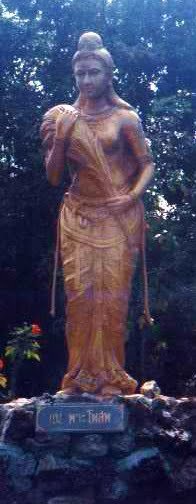
When rice plants begin to seed, the Thai expression is that the rice becomes pregnant. This is a crisis in the life of the plant, and therefore its khwan (spirit or soul) must be strengthened. It is believed that every living thing has a khwan, man, animal, and plant. When a person is ill, the khwan flees the body. Death means that the khwan does not return.
During every crisis of life–birth, puberty, marriage–a ceremony is performed to strengthen this spirit. So for the pregnant Rice Mother an offering is made of banana, citrus fruit, and sugar cane for her morning sickness. The farmer puts these foods in a bamboo basket which he hangs on a flag pole in the fields. This also serves as a warning to trespassers to keep their animals from treading on the rice plants. The farmer then takes a comb, toilet powder, and perfumed ointment and symbolically combs a rice plant, dabbing it with powder and ointment as though it were the Rice Mother herself. He prays that through his offerings the Rice Mother will thrive and not come to harm.
After the harvest, the rice missed in the reaping, representing the spirit of the Rice Mother, is gathered, with an entreaty to her to leave the field, where she may be in danger of prowling mice and birds, and to come and live in the barn instead. When the threshing is done, an offering of boiled duck eggs, sweets, and fruit is made to the Rice Mother. What rice paddy remains on the threshing floor is then put into a basket and called Mae Posop’s rice. This is the spirit or essence of rice. Next a doll is made from rice straw and mixed with some of this paddy–as an image of the Rice Mother–and is kept in the barn with the paddy essence. When the sowing of rice begins in the rainy season, the Rice Mother’s essence is taken out of the barn and mixed with the paddy to be sown, to insure fertility. The doll is then ceremoniously destroyed.
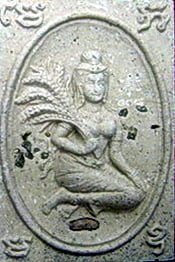
Even when not directly concerned with the cultivation of rice, the Rice Mother must be propitiated. At the end of a meal children often raise their hands palm to palm in thanksgiving to the Rice Mother.
It is said that her ire is incurred if, when eating, one allows grains of rice to fall to the floor, or if these grains are stepped on, or leftover rice is discarded. If one wishes to criticize the way rice has been cooked, one must beg the Rice Mother’s pardon first and then politely make one’s complaint.
When fed to animals – and it is, by the way, the main source of food for cats, dogs, pigs, chickens, ducks, cows, and buffalo – rice must be offered in a container, not scattered on the ground, for the Rice Mother’s wrath may be incurred. The threatening danger is that she will leave the offender, and only bad luck will surround him without her.
About the Author
Vipp Rongsit is an author and editor specializing in Thai food & Thai recipes.
Thai Recipes | Thai Soup Recipes | Thai Restaurants
Source: http://www.articopia.com
NEW – See this article translated into the Tamil language by Santhipriya here:
